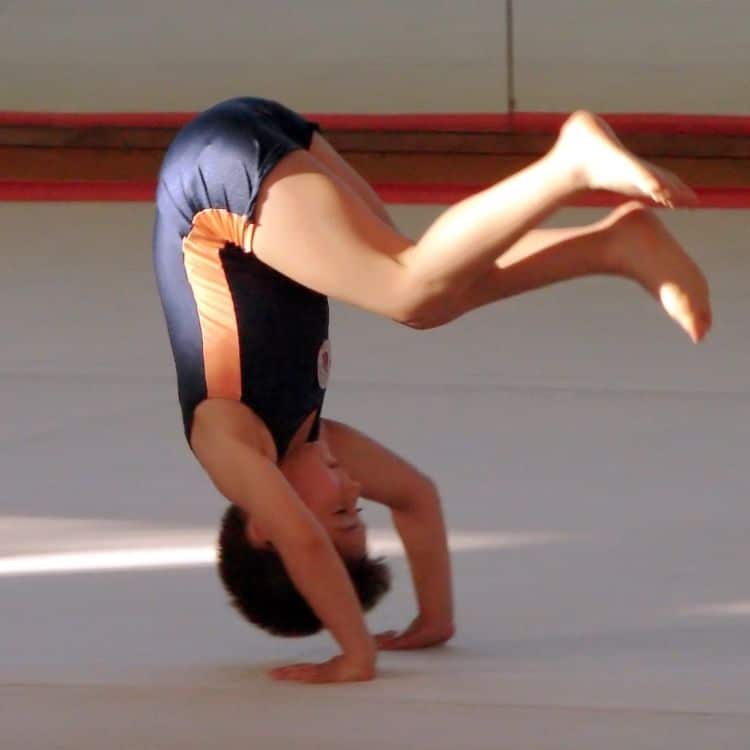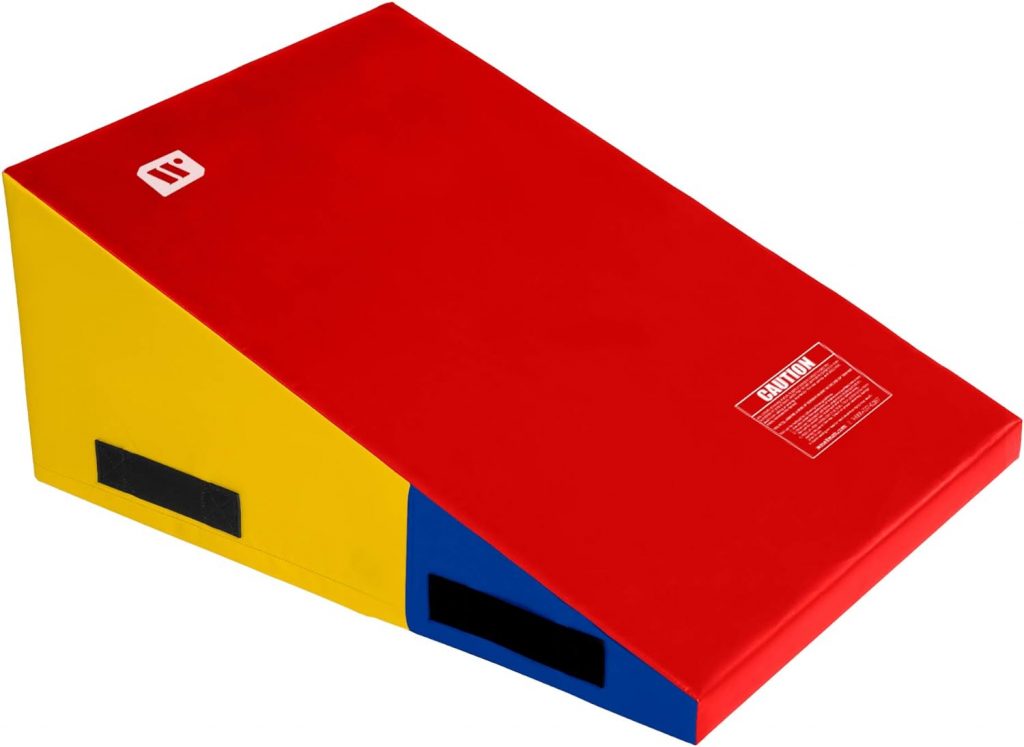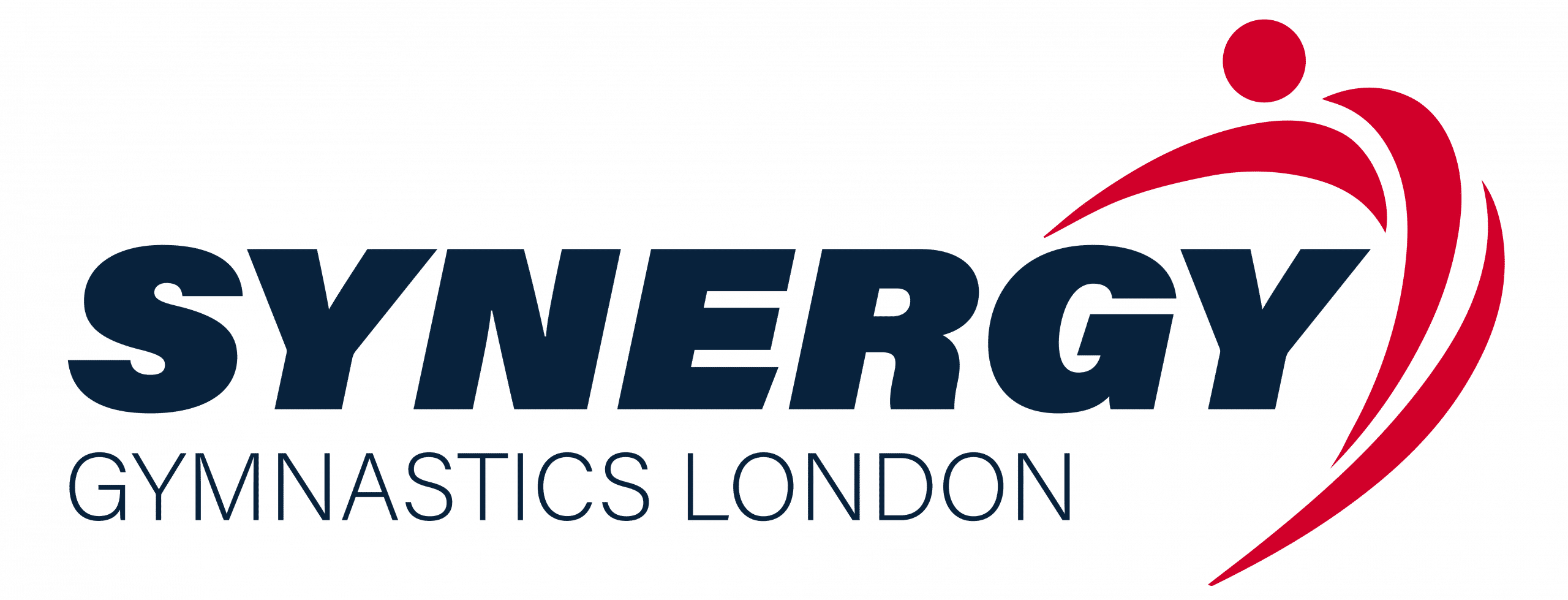A forward roll is one of the first moves that a beginner will learn in gymnastics. It is a building block for learning more advanced skills like somersaults and also helps gymnasts fall safely if they make a mistake.
But despite it being a basic skill, even beginners will need to understand some basic gymnastics body shapes before starting to forward roll.
If done badly, a forward roll can damage the neck and back so this article will help you understand the important steps in learning to forward roll safely.

Disclaimer: Gymnastics carries an inherent level of risk. Information contained in this article does not replace the need for professional coaching in a recognized gymnastics facility.
What is a Forward Roll in Gymnastics?
A forward roll in gymnastics involves the gymnast rotating their body all the way round whilst facing forward. Usually a gymnast will start on their feet, invert upside down by placing their shoulders on the floor and pushing through their feet to create momentum.
It’s a beginner move which helps gymnasts learn to control their body and is used to travel along the floor.
Once mastered, the forward roll can be performed in various body shapes and used on apparatus such as bars or vault. It will also lead to more advanced skills and routines.
How to do a Forward Roll
A basic forward roll uses two key gymnastics shapes – stretch and tuck. The tuck position is the easiest to learn as your body rolls more efficiently in a tuck shape. Once you have mastered the forward roll in tuck shape, you can introduce rolling in Pike and Straddle shapes.

Start in a standing stretch position
Starting in a stretch position makes the skill look neat and encourages smartness. To stand in a correct standing stretch position with good posture:
- Stand tall with arms stretched above your head
- Arms to ears
- Eyes looking forward
- Tummy sucked in
- Hips under
- Knees and feet together
Place your hands on the floor and tuck your head
From the stretched position, bend your knees and crouch down placing your hands on the floor.
Hands should be placed forwards of the feet but the gymnast should still be balanced at this point.
Tuck the head under so the chin is close to the neck. Leave enough room so that knees do not bump the face (this is a common injury with beginners) but make sure the head is tucked under enough not to hit the floor.
Lift Hips and Push off
Next, lift the hips so the gymnast is starting to move off-balance forwards. You want the shoulders to contact the floor first so keep the shoulders nice and round in the tucked shape.
Then push off the floor as if you are jumping. We are looking for a smooth and fluid roll so stay in shape and try not to hesitate.
Reach forwards and finish in stretch
Once a gymnast is 3/4 through the roll they should start to reach forwards out of the end of the roll. This will help keep enough momentum to stand up at the end.
A forwards roll performed correctly will finish in the same stretched position used at the start BUT don’t use your hands on the floor to help you stand up.
Equipment Needed
A cheese mat (also called a wedge or incline mat) is often used by gymnastics coaches to teach rolls as the added incline increases the momentum a gymnast needs to roll.
Start at the top and repeat all of the same steps you would use on a flat gymnastics mat.
Cheese mats are great for home use and can be picked up on Amazon for between $100 – $300. My favorite is sold by We Sell Mats as it folds and doesn’t have a drop at the low end.

Things to practice for forward roll
- Bunny Hops – Place hands on the floor, and jump both feet in the air keeping the arms straight
- Rock and Rolls – Sit in tuck shape on the floor, rock backward and roll forwards
Conclusion
A Forward roll in gymnastics is an essential basic move that all gymnasts need to master. Although it is basic, a successful gymnast will pay attention to body shaping and details in the technique such as keeping the feet together.
Once a tucked forward roll has been mastered, a gymnast can vary the shapes used to create new forward rolls such as Straddle and Piked.
Sign up for free taster session at Synergy and we’ll teach you how to forward roll properly!
FAQs
How do I get over my fear of forward rolls?
Although a forward roll is considered a basic move, it is common to develop a fear of rolling over your head forwards. That’s nothing unusual and you shouldn’t worry about it, even if you get dizzy.
If you want to overcome your fear a coach can help spot you and give a little bit of a push to turn your rollover.
What is the difference between a somersault and a forward roll?
A somersault is essentially a forward roll in the air. So the main difference is that you need to jump up for a somersault whereas you perform the forwards roll on the floor.
A great way to learn a somersault is by jumping up and rolling onto a high pile of pats. This helps develop the understanding of jumping into a somersault safely.
Once a gymnast can roll onto high mats a coach will take the mats away but ask the gymnast to still perform the roll at the same height.
The chances of serious injury are very high with somersaults as a landing on the neck or back has major consequences. For this reason, I highly recommend learning somersaults only with a professional coach in a safe environment. Self-taught gymnastics just doesn’t have the same amount of protection.
What muscles do forward rolls work?
A forward roll requires the core muscles to work, especially when trying to stay in the tuck shape.
Leg muscles such as calves, quads and hamstrings work hard in the push-off and stand-up phase of the roll.
What level is a forward roll?
A forward roll is a requirement for level 1 of the USAG Development Program for Women’s Artistic. This means it has to be included in a girl’s floor routine.
Level 1 is not compulsory therefore clubs and coaches mainly use it to prepare young competitive gymnasts.
- How To Get Over a Mental Block In Gymnastics: A Complete GuideGymnastics is a sport that requires not only physical strength and skill but also mental strength. When a gymnast feels like they cannot attempt a… Read more: How To Get Over a Mental Block In Gymnastics: A Complete Guide
- Find The Best Leotard For Girls (Guide)Finding an ideal leotard for girls isn’t just about picking a dazzling design that sparkles (although it does help!). The leotard has to fit perfectly,… Read more: Find The Best Leotard For Girls (Guide)
- The Best Gymnastics Shorts (Our Top Picks)The best gymnastics shorts are designed to be worn over the top of a leotard providing additional coverage around the upper legs, whilst allowing gymnasts… Read more: The Best Gymnastics Shorts (Our Top Picks)
- Decathlon Leotards – Are They Any Good?If you’re in the market for a new leotard, you may be wondering if Decathlon leotards are any good considering the low cost of their… Read more: Decathlon Leotards – Are They Any Good?
- A Complete Guide to Gymnastics Hand RipsAre you tired of dealing with painful gymnastics rips on your hands from training? Look no further – this article offers a comprehensive approach to… Read more: A Complete Guide to Gymnastics Hand Rips
- Is Gymnastics Dangerous? (Facts and Comparisons)Gymnastics is acknowledged as a highly technical and physically demanding sport. It inherently carries a risk of injury, which is why most coaches and clubs… Read more: Is Gymnastics Dangerous? (Facts and Comparisons)






